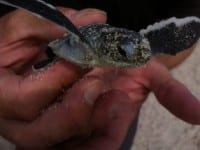UCF Counts Record Numbers As Sea Turtle Nesting Season Ends
 Sea turtles are making a comeback along the Brevard County coastline.
Sea turtles are making a comeback along the Brevard County coastline.
As the turtle-nesting season comes to a close today, researchers with UCF’s Marine Turtle Research Group are logging a record number of turtle nests.
“It’s amazing. We can’t believe these numbers,” said Kendra Cope, a graduate student who has been working with the research group since last summer. She is one of the handful of students who wakes up in the pre-dawn hours from March to October to locate nests, tag female turtles and count eggs. “Even now, toward the end of the season, we’re still counting new nests. It’s so satisfying to see the numbers climbing.”
As of early October, the team had identified 11,839 green sea turtle nests, 10,933 loggerhead turtle nests and 24 leatherback nests. By comparison in the early 1980s, there were fewer than 50 green turtle nests were recorded. The other species numbers have been climbing as well.
So why the record number of turtles?
“I think it is a result of three decades of conservation efforts and protecting their habitat,” said Llew Ehrhart, founder of the Marine Turtle Research Group at UCF. He’s been tracking turtles since the 1970s when he joined UCF’s biology department. His data was a key reason why Congress created the Archie Carr National Wildlife Refuge in 1991.
“Our Florida beaches are critically important to sea turtle populations,” said Ehrhart, who retired from the university in 2004, but has continued to help the team document the turtles. Ehrhart continues to get on a boat every month to count juvenile turtles in the Indian River Lagoon, which is part of another ongoing 30-year-study of the health of turtle populations in the area. “I think we’ve done a good job with our beaches. I think that’s one reason why we’re seeing this good season.”
UCF has a long history of studying loggerhead, green and leatherback turtles, which are all protected by the federal Endangered Species Act. The Archie Car Refuge, found along parts of Brevard and Indian River county coastlines, provides nesting habitats for approximately one-fourth of all sea turtles nesting in the United States. Green sea turtles, loggerheads and leatherbacks lay eggs along the 20-mile shoreline of the refuge each year during nesting season– March through October.
UCF scientists have been conducting several studies in Brevard for more than 30 years looking at long-term population trends in the Indian River Lagoon, reproductive behavior on the beaches and early life history and behavior of hatchlings as they make their way to sea.
Ehrhart, a quiet, but engaging man, said he can’t help but stand in awe each time a turtle is found and tagged. He was trained as a zoologist with a specialty in small mammals. When he arrived on the Space Coast he was helping monitor the wildlife refuge around the new Kennedy Space Center.
“I was working with skunks and rats,” he said. “Then one day I was in an office and the guy tells me, you know there are turtles laying eggs out there. I asked him how many. He tells me “I dunno.” I asked what kind of turtles. He said “I dunno.” Next thing I know I’m studying turtles.”
Three decades later, Ehrhart has earned a multitude of awards and recognitions for his research. Among the many accolades are: Pegasus Professor, UCF’s highest faculty honor; the Archie Carr Lifetime Achievement Award; the Carnegie Florida Professor of the Year, and the International Sea Turtle Society Lifetime Achievement Award. But the greatest satisfaction comes from two things, he said. His work has also been featured on PBS and New York Times among other outlets.
His greatest satisfaction comes from seeing the students he mentored contribute to the understanding of sea turtles and to what looks to be a recovery of the turtles. But much work remains, he is quick to say.
There are several challenges to sea turtles and marine creatures, especially in Brevard County. From polluted waters to fibro papilloma, which causes debilitating tumors, there are many obstacles to the turtles’ continued survival.
But this season’s record number of nests is good progress, Ehrhart said.
To view original article, click here.
